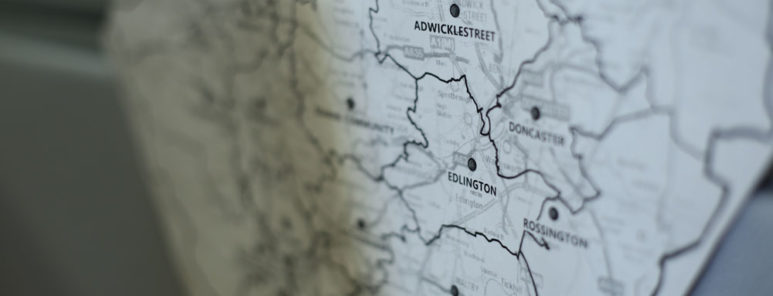This document is the Integrated Risk Management Plan for South Yorkshire Fire & Rescue.
Foreword
South Yorkshire Fire and Rescue has an overarching aim which is ‘making South Yorkshire safer and stronger’.
All of our fantastic staff joined this service to help the people of South Yorkshire and from every frontline firefighter, to every member of dedicated support staff, they all work to achieve our aim. The Fire and Rescue Services National Framework document (published in 2018) sets the requirement for us to design and deliver this plan.
It is also important to deliver this plan as it reassures the public that we take time to understand the risks they face from fires and other types of emergency, and carefully plan how we can reduce those risks through the services we deliver.
The service has faced some significant financial challenges over the past ten years. We have responded well to the financial situation, with significant reductions in the amount of money allocated to us from central government. The future financial picture is far from certain and this often makes planning for the long term more difficult.
However, the service continues to adapt to changes in society and it is our intention to continue to deliver an excellent service to the communities we serve- placing a strong focus on those most vulnerable to fires and other emergencies.
We will work across all of the local authority areas of Barnsley, Doncaster, Rotherham and Sheffield and, alongside our key partners from within the local authorities and other agencies such as South Yorkshire Police and Yorkshire Ambulance Service, we will work collaboratively to provide the best value for our communities.
Our focus is to prevent emergencies happening in the first place, to protect local buildings and workplaces so that our local economy can prosper and to respond effectively if an emergency does occur. We have dedicated, professional people and we will continue to strive to improve what we do to ensure the safety of everyone across South Yorkshire.
Alex Johnson Chief Fire Officer
Robert Taylor Fire Authority Chair
Introduction
More than 1.3 million people rely upon us to provide our service to them. They rightly expect us to do this in a planned and coordinated way, matching what we do and the work we prioritise to the different risks they face. Understanding and reducing risk in our communities is crucial to this- and to achieving our purpose, which is ‘making South Yorkshire safer and stronger’.
The way fire services assess and reduce risk is through something called an Integrated Risk Management Plan (IRMP). This is an up-to-date analysis of local risk and describes how we will effectively coordinate our work to improve public safety and save lives.
This plan does not describe everything we will be doing over the next few years. For example, our annual service plan describes our yearly priorities for changing and improving our service. What this plan does describe though, is the steps we’ve taken to understand risk in South Yorkshire and the work we’re taking now and in the future to address it.
Why we are here
Our purpose is ‘Marking South Yorkshire safer and stronger’. To achieve this we will deliver the following key services:
- PREVENTION – to raise awareness of the risks people face from fire and other types of emergency. This will focus on those most vulnerable
- PROTECTION – to promote and enforce fire safety arrangements in buildings that fall within relevant legislation. This is to ensure buildings and occupants are as safe as possible
- RESPONSE – to have trained staff ready and able to respond to a variety of emergency situations, equipped with the best vehicles and equipment to do their job as effectively as possible
- RESILIENCE – to deal with major emergencies that demand significant resources or require the support from other services and agencies, whilst still continuing to deliver business as usual activity across the county
Our first goal will always be to save lives and make people safer. This is what we do every single day, whether it’s responding to 999 calls or carrying out work to prevent emergencies from happening in the first place. Much of our work goes beyond this though, from improving the life chances of young people and protecting businesses, to helping to tackle other issues like crime and healthcare. Our organisation’s purpose extends therefore to making our communities stronger places for the future.
Who we are
As a fire and rescue service we are responsible for delivering a wide range of services to our communities. These are set out clearly in the Fire and Rescue Services Act 2004. We also have specific duties under the Civil Contingencies Act 2004 and the Regulatory Reform (Fire Safety) Order 2005. The service is governed by the South Yorkshire Fire and Rescue Authority. The Fire and Rescue Authority is made up of 12 councillors from the four metropolitan district councils of Barnsley, Doncaster, Rotherham and Sheffield. The Police and Crime Commissioner for South Yorkshire also sits on the Fire and Rescue Authority. The Fire Authority funds the service and works closely with the Chief Fire Officer/Chief Executive to decide how our services can be provided in the most efficient and effective way.
Our firefighters respond to a wide range of emergencies including building collapse, rescues from height, water rescues and many other types of ‘special service’ incidents. However, whilst our work responding to 999 calls is both well-known and well valued by the public, far more of our contact with local people is actually through our varied and extensive work to prevent incidents from happening in the first place.
To deliver this work, we employ more than 600 people, most of whom are firefighters. The majority of these are wholetime firefighters, which means they are available to attend emergency incidents 24 hours a day. A smaller number are ‘on-call’ firefighters, meaning they live or work in the communities they serve and, often, provide on-call emergency cover from these places. Our firefighters are supported by teams of support staff who provide a wide range of specialist services. This includes community safety work and our responsibilities to enforce business fire safety laws. We also work with a network of volunteers to further extend our reach to educate the public and prevent emergencies.
We will continue to attract, select and develop the best people as we recognise the importance that our workforce plays to achieving our overarching aim. We invest in the health and well-being of our teams, we provide leadership development and promote the right values and behaviours across the whole organisation. We place equality and fairness at the heart of everything we do and recognise that we need to continue to work to improve the diversity of our teams so we are more representative of the communities we serve.
Where we are going
We recently worked with our staff to develop a new, long term vision which explains how we aspire to become a leading fire and rescue service. ‘Our Story’ clearly sets out our established objective of ‘making South Yorkshire safer and stronger’. It also explains the behaviours we expect our staff to display, regardless of rank or role, and describes our aspirations for the future. Together, it all forms an essential part of everything we do.
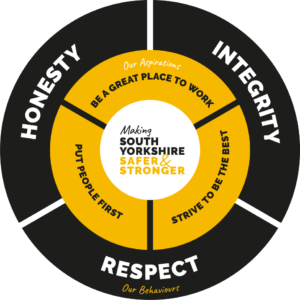
Who we serve
We serve the public and communities of South Yorkshire. As a metropolitan county, South Yorkshire has the usual mix of risks associated with a large, urban area. That’s everything from sports stadiums, shopping centres, high rise flats and historic buildings, to a vast transport network of road and rail, as well as an international airport. The new HS2 high speed rail line will also pass through the county. Our population density is more than double the average for England, with significant areas of deprivation.
Yet, our status as a metropolitan service does not tell the whole story. For example, the geographic area we cover is actually big when compared to other similar fire and rescue services with more sparsely populated, rural areas and even part of the Peak District national park forming part of our county too. This ‘sparsity factor’ means our fire stations are more spread out than other metropolitan services and this inevitably impacts on our speed and weight of response to emergencies. Our geography has also affected our funding, because we’re neither urban enough, nor rural enough to do well in the way the money we get from government is currently calculated.
What local people say
To help us produce this plan, we’ve used focus groups and surveys with representative samples of local people to ask them what they think about the work we do, what they would like us to focus on in the future and their views on our future 999 response time arrangements. People told us that they greatly value our service and they think we provide good value for money. They strongly value all of our core services- prevention, protection and response with our ability to respond quickly and skilfully to a wide range of incidents the thing which they value and would like us to prioritise the most. The public told us that they expect us to attend all 999 calls as quickly as possible and they are concerned about introducing anything perceived as a ‘target’, which could place extra pressure on an already pressurised service. However, when considering different response time options, the public overwhelmingly told us that they would prefer to introduce a set of response times which prioritise the severity of an incident and the level of risk in a geographic area, instead of a single response time for the whole of the county.
Understanding and managing risk
We have undertaken a process to consider the whole range of foreseeable fire and rescue related risks and developed this plan to explain how we will work to protect our communities and respond to emergency incidents when they occur, balancing our resources against local risk.
Experience tells us that certain incidents such as house fires and road traffic collisions are more likely to occur than more significant incidents such as a train crash or large industrial chemical release. Although the latter may have a more significant impact on the community, they are much less likely.
Therefore, we direct our prevention, protection and response resources to provide the greatest possible return on investment by reducing the overall impact of the foreseeable risks we face. In summary, we:
• Use evidence, insight and professional experience to list all the risks that we face
• Assess how likely each risk is to threaten life, property and the environment
• Model the level of risk in small geographical areas to create a ‘risk profile’
• Use this information to understand where to base our people and resources
There are lots of different types of risk and some of the main ones we face are described below.
Community and house fire risk
Although it is impossible to predict exactly when or where a fire may occur, we are able to profile the areas and people that are more at risk and vulnerable to fire. In simple terms, our risk analysis shows that some areas and people are much more at risk and vulnerable to fire than others. Analysis of incident data and studies into what makes someone more likely to have a fire also shows that there is a very strong link between fire and deprivation. The more deprived an area is, the more house fires there are likely to be. It’s also likely that those fires will be more severe, possibly resulting in someone being taken to hospital or even dying. Understanding all this, and using data sources like the English Index of Multiple Deprivation, is really important for supporting our integrated risk management planning because it is unlikely to change very quickly in the future. We explore our risk model in more detail, later on in this plan.
High-rise residential building risks
We already know that high-rise residential buildings present different risks compared to other types of home. One of our roles has always been to understand and reduce this risk for our area. The Grenfell Tower disaster and the inquiry and building safety reviews which followed it have rightly put renewed focus on this part of our work. We have already taken steps, along with other fire and rescue services around the country, to consider the risks particularly affecting high– rise residential buildings which were built using a particular type of cladding. Now, we are turning our attention to auditing all other high-rise residential buildings in our county.
Transport and other special service risks
We don’t just attend fires. A large proportion of our emergency calls are classed as ‘special service calls’. Lots of these are road traffic collisions. With high population density in our urban areas we can expect a significant number of road traffic incidents in these areas. However, they also occur on more rural roads, away from populated places. Where these incidents are likely to occur is more difficult to predict because analysis of our data shows that they do not necessarily match areas of increased deprivation like fires do. We know that response to road traffic collisions can be affected if they occur in more rural areas or if there is a significant build-up of traffic due to the collision, which can impact on attendance times. We currently undertake partnership work with other agencies with the aim of reducing the number and severity of road traffic incidents and we focus this work on those most vulnerable and at risk such as young and inexperienced drivers. Other types of special service calls include extrications from collapsed buildings or machinery, flooding, water rescues, rescues from height and lift rescues.
Commercial and industrial risks
Homes aren’t the only types of buildings which can catch fire, with lots of the calls our firefighters attend involving non-domestic buildings. Some of these premises have their own particular risks to consider from hospitals and hotels, to petrol stations, sports stadiums and waste recycling sites. To help prevent major public and environmental accidents, some premises are required by law to produce emergency plans to mitigate on site accidents involving substances that the premises produce, use or store. The legislation is called the Control of Major Accident Hazards Regulations 2015 and the premises it relates to are known as COMAH sites. There are eight of these in South Yorkshire. We are the local authority responsible for COMAH sites in South Yorkshire, which means we have the responsibility for preparing, reviewing, testing and exercising external emergency plans for upper tier sites. These plans are designed to formulate a response and mitigate off-site impacts of a major accident.
Environmental risk
The impact of climate change and the increase in extreme weather conditions (e.g. heatwaves) has the potential to increase environmental incidents such as flooding and wildfires which may in turn place extra demands upon our resources. The most recent major flooding which hit South Yorkshire was in November 2019, with parts of Doncaster particularly badly affected for several days. The last major flooding before this was in 2007. The term ‘wildfire’ meanwhile refers to any large fire in open countryside, like grass and scrubland or moorland and woods. Large scale wildfires are quite rare, but when they do occur they can take a long time to tackle and often require the use of lots of firefighters, fire engines and other specialist equipment. They can also cause significant environmental damage. With part of our country bordering the Peak District national park and other areas of moorland and sites of special scientific interest, the risk of wildfires is higher than in some other parts of the country. National analysis also suggests that the frequency of this type of incident could be increasing as a result of climate change. On occasions, our firefighters also attend incidents which involve working in or around water, ice and deep mud. Specially trained crews are expected to attend these types of incidents with the purpose of saving life or giving humanitarian aid.
Heritage risk
The term ‘heritage risk’ relates to historic buildings, stately homes, monuments, museums, historic parks and other attractions. There were 823 new Grade I and II* listed buildings, monuments, archaeological sites, landscapes and conservation sites at risk across the Yorkshire region in 2016. South Yorkshire itself is home to a number of national heritage sites and although the number of these sites in comparison to domestic dwellings is few, we recognise the unique risk they pose if involved in fire. For obvious reasons, this type of risk rarely changes. Sites remaining on the ‘at risk’ register in South Yorkshire include Broadsworth Hall, Conisbrough Castle, Wentworth Woodhouse, Monk Bretton Priory, Roche Abbey, Oakes Park, at Heeley, and structures within Sheffield General Cemetery, Sharrow. The most important buildings also have their own salvage plans should a disaster occur, which are made available to us and enable us to mitigate the damage in the event of fire, flooding or any other emergencies.
National risk
The National Risk Register takes into account all national risks, but not all apply to South Yorkshire. These risks are nationally graded and then locally analysed to see if and where they sit within our community risk register. The risks which currently feature highly for South Yorkshire are:
• National pandemic
• Coastal flooding
• Widespread electricity failure
• Catastrophic terrorist attacks
• Poor air quality events
• Crowd related disorder
• Severe weather flooding
• Dam reservoir failure or collapse
Locally, we play a leading role in the work of South Yorkshire Local Resilience Forum and are members of its associated sub-groups. The forum brings together all agencies with a significant role to play in responding to and recovery from the effect of emergencies, and was formed to meet the requirements of the Civil Contingencies Act 2004. Its work includes making sure responders work together to minimise community risk and respond collectively in the most appropriate and effective manner where emergencies occur.
Future risks
Risk changes all the time. Some things can emerge very quickly, with the Covid-19 pandemic a very recent and stark example of this. Other risks emerge more slowly, such as population changes or new housing or business developments. Our job is to review these risks regularly. This will involve us regularly reviewing our community risk model and working with partners including local and national government to understand the changes which could affect South Yorkshire in the future. We will capture all such risks on a foreseeable risk register and consider what resources we have in place to reduce these risks through a combination of prevention, protection, response and resilience capabilities.
The majority of emerging risks will be covered by our existing resources. However, we must continue to maintain our awareness of these risks to ensure that we do have the resources in place to reduce any that may arise. Emerging risks include new housing or business developments and changes to transport infrastructure. We have measures in place to keep informed about these things as we are statutory consultees for major housing and commercial developments. We must also continue to learn and we have a dedicated team who will capture learning from local, regional and national emergencies and consider any gaps in our current capability.
This work will continue into the future with the aim being to keep our firefighters as safe as possible when responding to incidents. It will inform our operational policy, how we train our staff and the equipment we use to ensure we are prepared for all foreseeable risks that we face. We are currently in the process of increasing the resources we have for our internal Operations Support Team, including the development of a dedicated Firefighter Safety Team that will help provide this essential function.
Integrated risk modelling
A ‘risk model’ is a way of using data to work out which parts of the county are most at risk when it comes to fire and other emergencies. We define risk as ‘the potential for an emergency to occur that may threaten life, cause injury or damage property or the environment.’ We’ve developed a revised methodology (awaiting hyperlink) for how we plan to assess risk across the county. This includes a detailed analysis of specific data sets that determine the risk of fires and other emergencies occurring. This helps to inform our response, prevention and protection activities to mitigate these risks.
There is lots of information which can inform how we deliver our services across the county. The key is selecting the most appropriate sets of data to give us the best chance of putting our resources in the right places at the right times to protect the communities of South Yorkshire. This is constantly being refined as new data emerges and we develop our ability to interpret this data which in turn informs our decisions. We have selected some examples of the data we use to inform us about risk within the community with an explanation of how we use them below.
This map shows the levels of deprivation across South Yorkshire, by area. It is taken from a national data set called the Index of Multiple Deprivation (IMD). The red zones are the areas with most deprivation, the green are the areas with least. When we talk about deprivation we mean things such as low income, employment, health and education levels. The IMD provides us with a useful indication of risk because areas that are more deprived tend to experience more fires. The benefit of this data set is it is produced every three years by the government and is less susceptible to short term changes. For example, if we experienced a particularly quiet year of operational activity, the base IMD would still reflect the risk that exists due to the deprivation index. this map to help inform our prevention activity, with the aim of targeting our efforts at those most at risk. This map can change quickly if there is a spike in incidents within one particular area. This makes it useful to inform our prevention activity as we can deploy our resources into any area of South Yorkshire to react to spikes in activity.
This map shows a heat map based on our previous incident activity. We have specifically used the previous three years of data to show where we experience emergency incidents over a longer period of time. These are just some examples of how we can use the data that is available to inform our work. More information on these data sets and others can be found in our Integrated Risk Management Methodology document (insert link once known). We know that it’s very important that the public have faith in the risk models we use. That’s why we’ve used external specialists to analyse how we use data to inform our understanding of risk and we will continue to develop it further, to make sure that the assumptions we’ve made about risk in our area are accurate and up to date.
Prevention, protection and response
There are three main ways we address the risks we have identified in our area. These are to:
- Prevent emergencies from happening in the first place through safety education and engagement with our communities
- Protect buildings by checking compliance with fire safety laws
- Respond to emergencies quickly and professionally
Making sure all these strategies work together effectively to make the biggest impact is what we mean by ‘integrated risk management’.
Prevention
A key responsibility for any fire and rescue service is to prevent emergencies before they occur. We do this by using data to carefully direct our work at the people and places where it will have the greatest impact. This has already produced big results. In 2019/2020 for example, we recorded the lowest ever number of accidental house fires in South Yorkshire. More homes than ever before are also fitted with smoke alarms. As the number of incidents reduces, we must become even more targeted in how we deliver high-impact, resource intensive work like Home Safety Checks. Home Safety Checks are where we visit people’s homes and give people specific advice on reducing their fire risk, help them with tailored escape plans and provide fire safety equipment, like smoke alarms. We now only deliver these visits in the homes of people who we believe are more at risk of fire, based on some clearly defined criteria. We also now co-create and co-deliver a range of education packages through our joint police and fire community safety department.
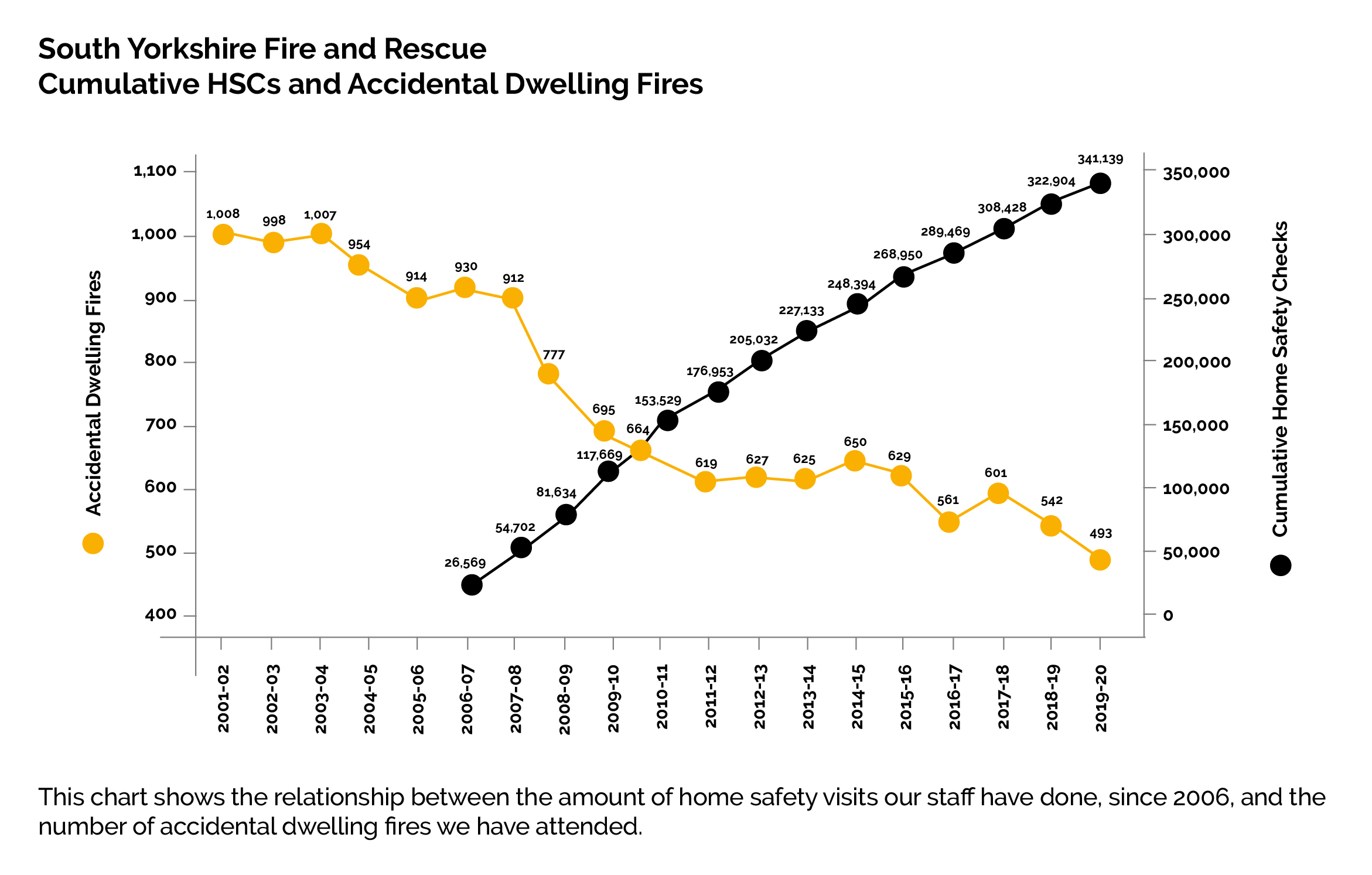
We also use sophisticated computer software to help us model where we should target these visits based on lots of different data sources, such as census and deprivation information, anonymised healthcare data and our own house fire statistics. In some cases we also now offer a wider range of advice to the public in what we call ‘safe and well visits’. This is where specially trained staff deliver advice on behalf of partners, for example around crime prevention, falls prevention and healthy aging. We do this because we recognise the role we can play to support wider public health goals and because there is a clear link between vulnerabilities such as falls and isolation, and the risk from fire. Another big part of our prevention story is our work with schools and young people.
We visit schools at key times in a child’s education to talk to them about keeping safe from fire, plus other risks like roads and water. We carefully design our education packages so that we are delivering the right messages, to the right children, at the right age. Where necessary, we also prioritise school visits in areas which we know tend to be at higher risk of certain types of incident.
Alongside our partners, we invite every year six pupil in South Yorkshire to receive education at our film-set style Lifewise Centre, which we jointly run with South Yorkshire Police. We also believe risk management involves building resilient and sustainable communities. Improving the life chances of young people delivers a long term social return on investment because of known links between employability and demands on public services. This includes someone’s susceptibility to fire, but also extends to other issues such as crime, healthcare and the economy.
We deliver this through schemes like Princes Trust Team Programme, which is a 12 week personal development course for unemployed 16 to 25 year olds, delivered jointly with South Yorkshire Police. It offers work experience, qualifications, practical skills, community projects and a residential week. Individuals gain new skills and qualifications, mix with new people and make new friends, get help with job-hunting and CV writing and most importantly a big boost to their self-esteem.
Other initiatives for young people include our seven fire cadets branches and the delivery of Achieving Respect and Confidence (ARC) courses, which are short, fire station based courses designed to highlight the consequences of antisocial behaviour. Lastly, whilst we cannot realistically speak to every single person in South Yorkshire about safety face-to-face, there’s lots we can achieve through public information campaigns. Many of the safety campaigns we have delivered in the last few years are proven to have helped reduce common types of incident, like cooking and electrical fires.
Protection
Protection is the term fire and rescue services use to describe their work to enforce fire safety laws and reduce the risks in different types of building.
Most of this work focuses on nondomestic premises like shops, factories, offices, warehouses, hospitals, sports stadiums and hotels. There are other premises too like petrol stations and fireworks retailers which have their own special regulations and licensing arrangements, which we also oversee and enforce. There are thousands of commercial buildings in South Yorkshire and it’s not possible with the resources available to us to check them all regularly.
Instead, we use something called a ‘risk based audit programme.’ This is a way of prioritising which of these buildings we inspect most often based on different things, such as whether people sleep in the buildings at night or the types of processes a business undertakes. We still check lower risk premises, but do this less often.
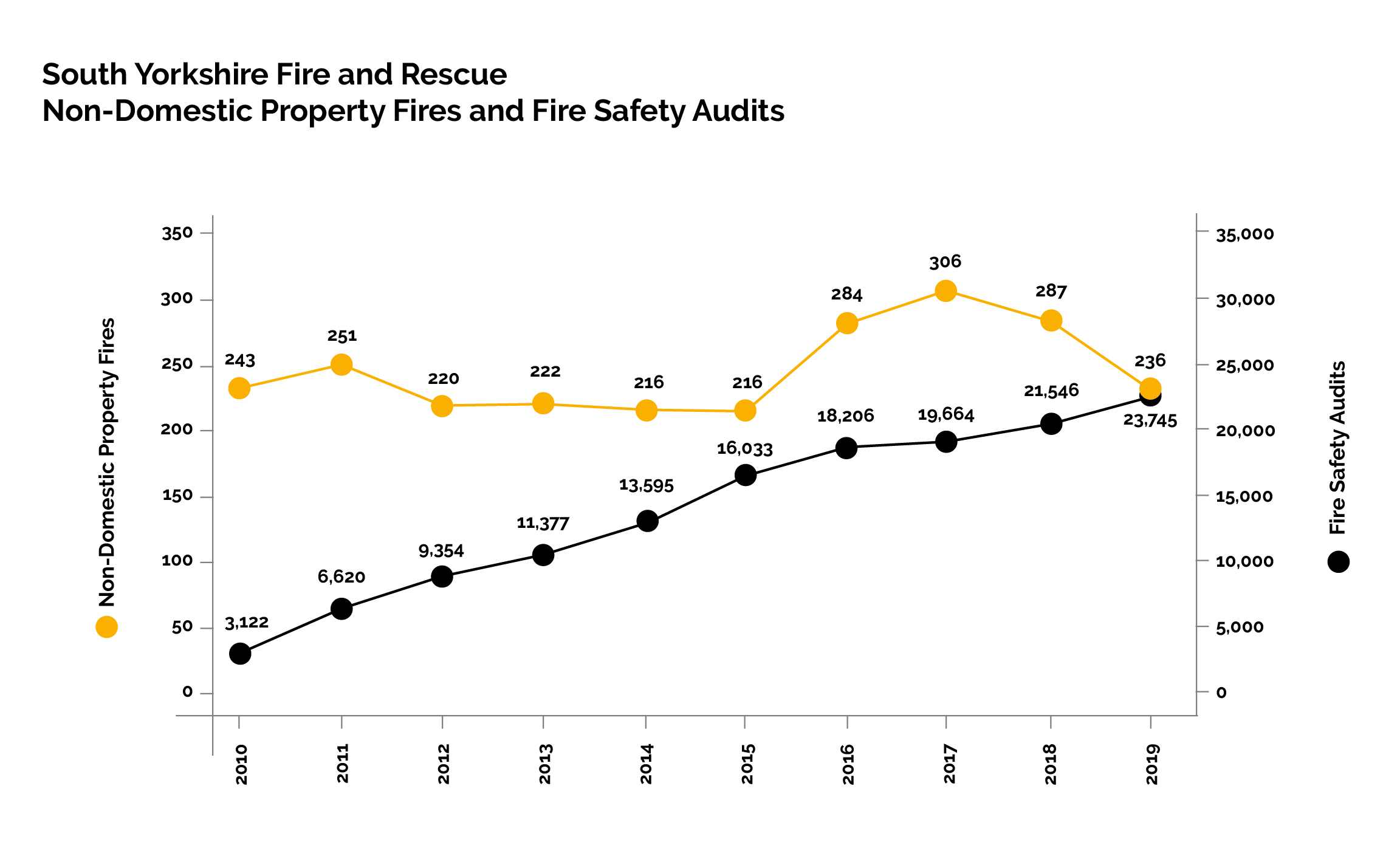
For example, there is generally less risk associated with something like a small shop, compared to a premises like a hospital. We also set aside some of our business fire safety inspectors’ time to respond to complaints from members of the public, who might have spotted a safety issue with a building and then reported it to us. Aside from businesses, we are also responsible for ensuring high-rise residential buildings comply with fire safety laws.
This is an issue which has particularly come to the fore following the Grenfell Tower disaster and subsequent inquiry and building safety reviews. The immediate concern nationally was to address safety concerns relating to buildings with ACM cladding which were over 18 metres tall. This work has now been completed. Now, attention is being given to checking the safety of thousands more non-cladded, high rise buildings across the country- more than 200 of which can be found in South Yorkshire.
The Home Office has provided us with some specific funding to address this at a local level and we are using this to set up a temporary ‘building risk review’ team. The team’s main responsibility will be to triage, inspect and desktop audit these premises by December 2021, in line with the target laid down by government. Another part of our protection work we’re very proud of is our long standing advocacy of sprinklers. We believe sprinklers are a cost effective way of making buildings safer – they stop fires from spreading, put them out quickly and save lives. We particularly support their use in commercial settings and high-risk residential buildings, for example where people with mobility or mental health conditions may be unable to react quickly enough to a smoke alarm alerting.
Response
Whilst we would much rather prevent emergencies from happening in the first place, we are best known for our ability to respond to a very wide range of emergencies using the skills and equipment available to us. Our response to emergencies involves several functions. From firefighters on fire stations who respond to incidents in the first instance and more senior officers who support and may take charge as incidents escalate, to our Control room operators who take 999 calls, support the public and dispatch our staff and vehicles to incidents.
Calls we respond to include:
• Fires
• Road traffic collisions
• Specialist rescues, including from water, confined spaces and height
• Flooding
• Animal rescue
• Gaining access to assist other agencies
We can’t afford to have fire engines and fire stations everywhere, so we aim instead to put them in the places where they are needed the most based on the risks we are likely to face. The majority of our fire stations are permanently staffed so firefighters are able to respond immediately to an emergency.
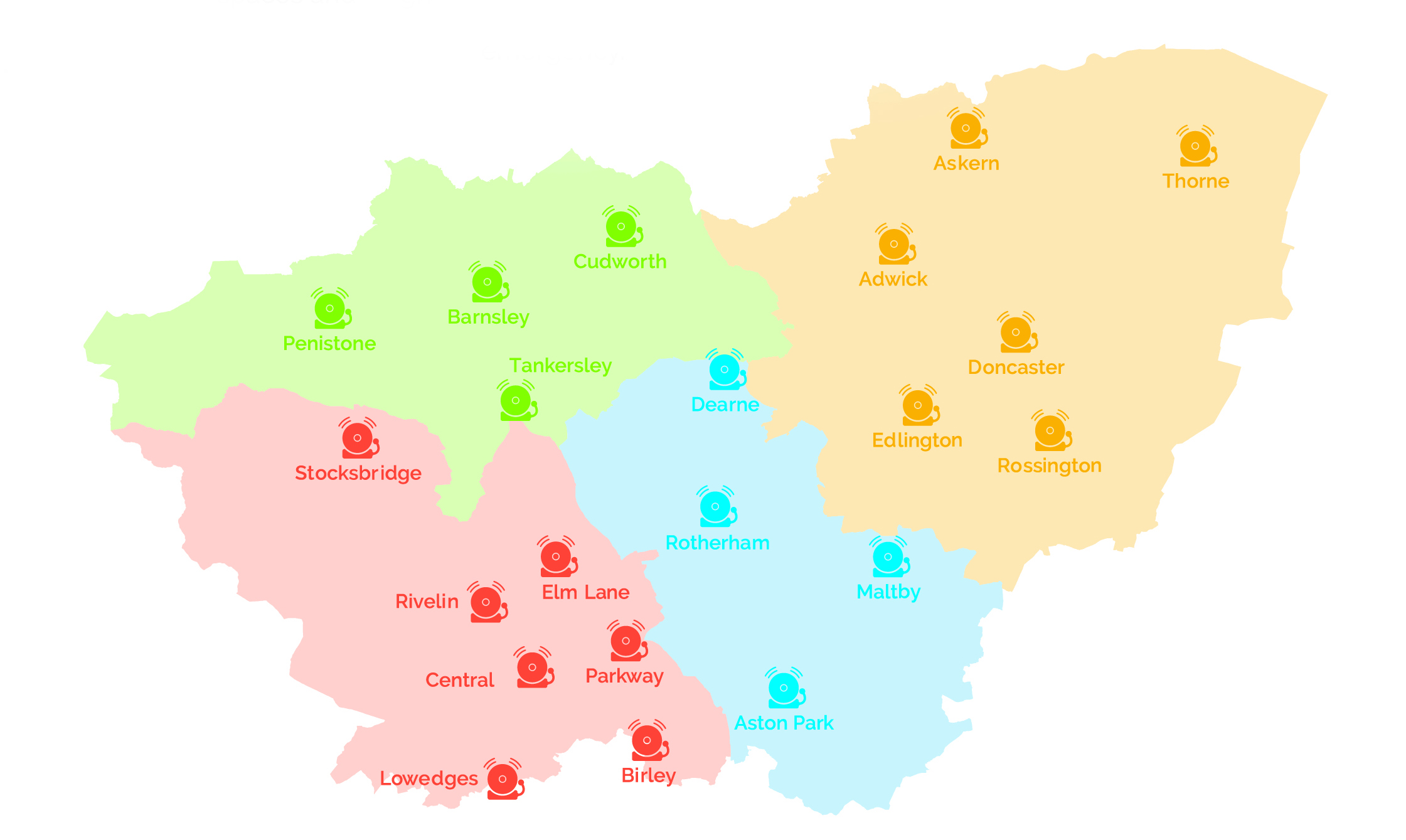
Other fire stations, in areas where we experience fewer emergencies, are staffed using on-call firefighters who will respond from home or work to their local fire station if there is an emergency. In addition to normal fire engines, we also have some very specialist equipment, like high reach appliances, boats, very powerful pumping equipment and decontamination vehicles, which are placed strategically across the county so that we can call upon them if needed. This map shows the location of our 21 fire stations that are positioned strategically across South Yorkshire.
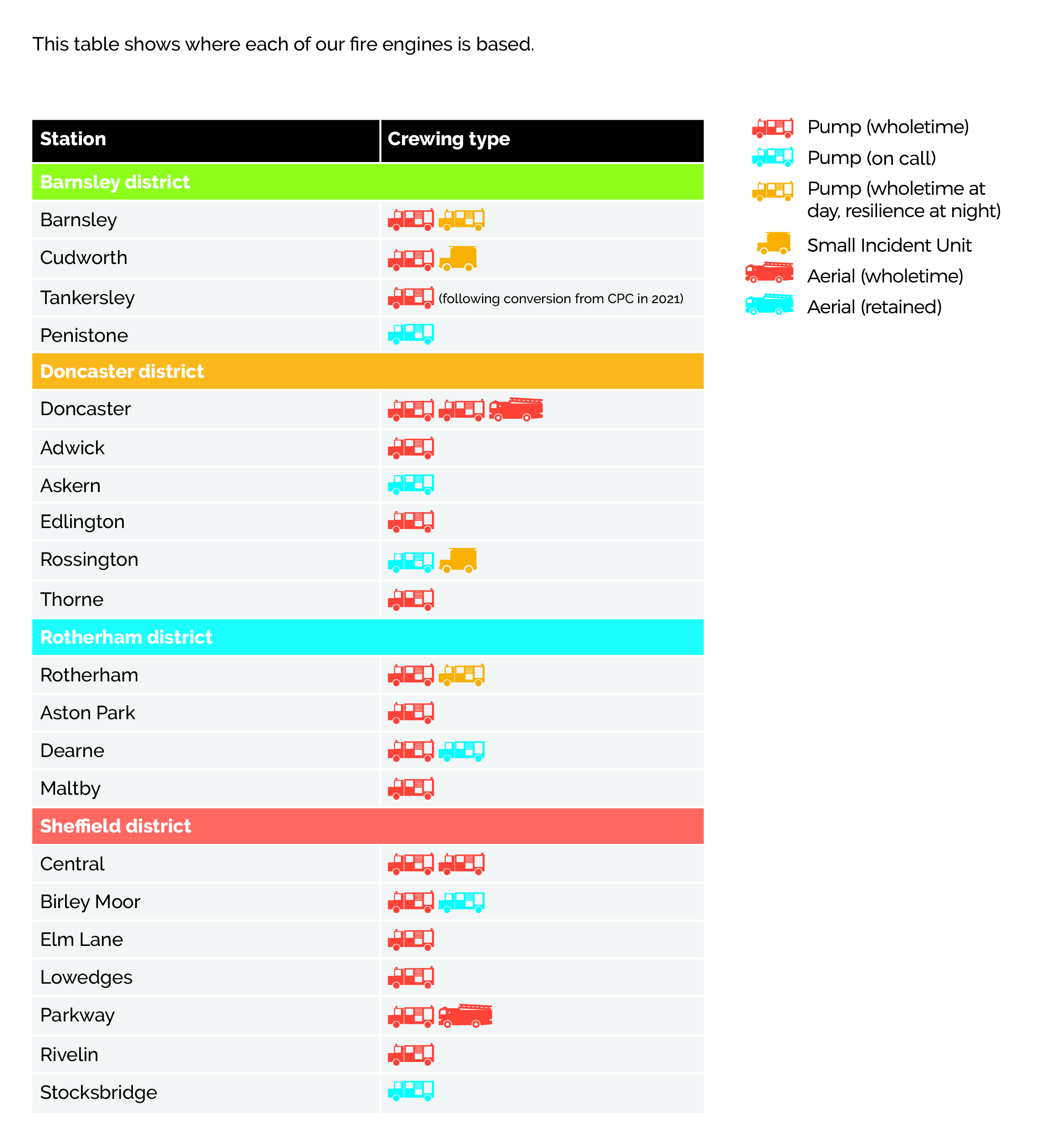
Response times
A national inspection reported that it was undesirable for us not to have a set of response standards for how quickly we respond to 999 calls. We currently aim to get to emergencies as fast as we can, every time. We will continue to do this, but we also aim to become more sophisticated in how we allocate our resources and respond to emergencies based on two specific factors:
1. The level of risk that exists within different areas of the county, and
2. The severity of the incident we are called to attend Our total response time is made up of the length of time it takes for a 999 call to be handled, a fire engine to be mobilised, firefighters to crew that fire engine and the travel time for that fire engine to arrive at an incident.
The overall response time can be broken down into different elements, as shown below:
All three elements of the total response time are important, but the second two elements (turn out time and travel time) determine the most appropriate location of our fire stations and the staffing models we use. They are also the critical element of the response times which we plan to set.
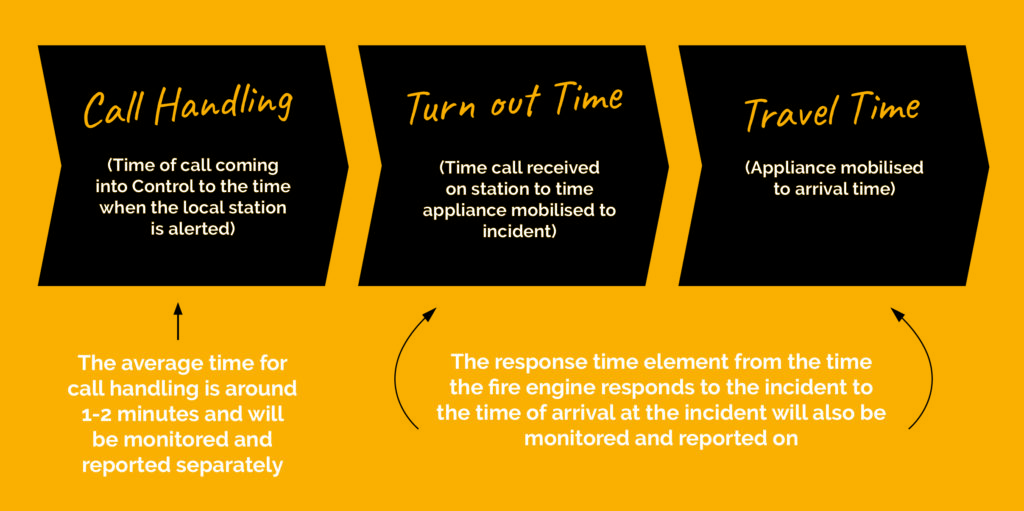
Most fire services use a set of expected response times which varies according to factors such as whether someone’s life is at risk and according to the level of risk in a particular area. Adopting this approach will allow us to ensure we are placing resources in the right places at the right time to best protect the communities we serve.
To be really clear, we will still aim to get to each emergency as fast as we can, but having a set of response times means we can measure our performance to ensure we are delivering the best possible service to our communities with the resources we have available to us.
To inform our response times, we have used some of the information and data described in the Integrated Risk Management Modelling section to produce a risk map of the county.
This will determine three risk categories (High, Medium and Low). Next, we turn our attention to the different types of incident, shown in the table below. Each is given a risk category (High, Medium and Low) based on the type of incident and the respective risk to life.
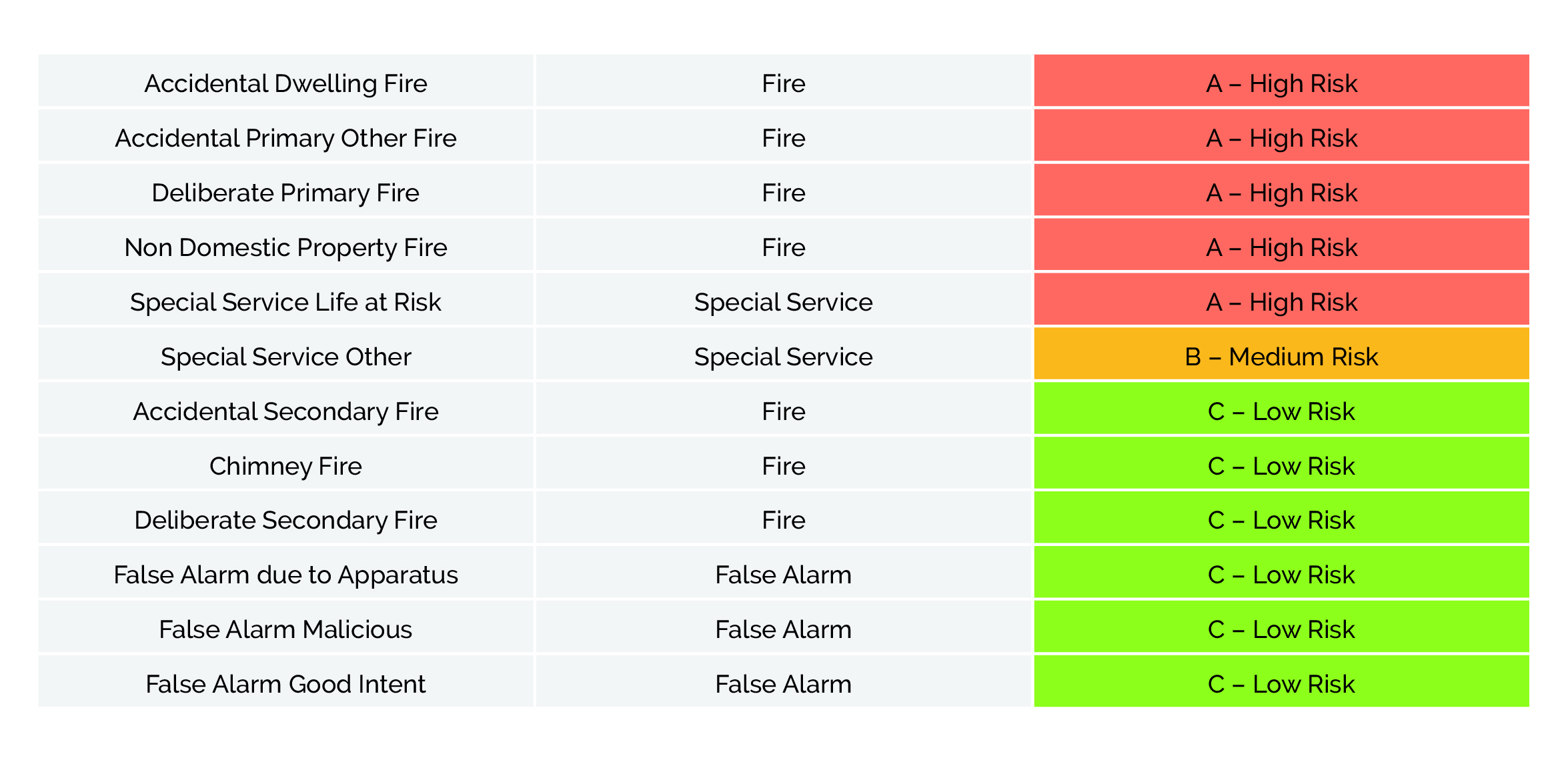
In developing our response times for the county, we employed the skills of a specialist risk management consultancy, who analysed our method for assessing risk in addition to looking back at our performance over the past three years. This included a detailed analysis of the response times to the areas of risk we have identified that in turn informed us about what our response times should be. From this work, we have determined the response times in the table below:
| Incident type | |||
| Risk category (community) | High risk | Medium risk | Low risk |
| High | 7 minutes | 9 minutes | 11 minutes |
| Medium | 9 minutes | 11 minutes | 13 minutes |
| Low | 11 minutes | 13 minutes | 15 minutes |
The service is developing a system that will allow us to monitor and report our performance against these response times. We have GPS information showing where each fire engine is located at all times and we can determine the closest resource to send to any emergency when it occurs. We are also planning to introduce some more technology to assist this process in the coming months. There will be occasions when we will be unable to arrive at an incident within our response time and this can be for a variety of reasons (for example, traffic congestion) but we will endeavour to understand why and seek to continually improve in order to prioritise our response performance at all times.
Resilience
Occasionally, we experience large scale incidents that require us to call in support from other fire and rescue services. This is captured in local regional agreements. Not only do we sometimes request support we will send firefighters and equipment from South Yorkshire to help other services if they are dealing with a major emergency. Being resilient means we must have such plans in place and this also ensures we can still deal with any normal activity across the county whilst also resourcing a large scale incident that may last several days or longer.
National resources are strategically located within fire and rescue services throughout the UK to provide an emergency response to larger scale incidents and disasters. In South Yorkshire, we host a suite of specialist resources that can be deployed anywhere in the UK. These include a High Volume Pump (HVP) which is used for widespread flooding incidents where greater pumping capacity is required. We also have a Detection Identification and Monitoring (DIM) vehicle, which can be used to identify and monitor hazardous substances. These resources are not only available for national deployment- they can also be used to support local response to any incident where they would be required within South Yorkshire.
What we are going to do
Following the development of our risk model and associated response time arrangements, over the course of this plan we now intend to:
- Further develop our risk model so that we use even more sophisticated datasets to plan our prevention, protection and response work and distribute our resources accordingly
- Introduce the expected response time standards we’ve described in this plan, so that our performance can be more effectively measured and we can deliver an even better service to local people
- Review our special attributes so that we can make sure we have the right vehicles and skills in the right places, according to our risk model
- Further target our prevention and protection activity at the people and places where they will have the greatest impact, based on our risk model
Money and resources
South Yorkshire Fire and Rescue is funded by the taxpayer so we need to ensure we are allocating our resources in the most efficient and effective way. Our annual budget is £55m. After a decade of austerity measures, fire services nationally have seen their core spending power reduced by 28.55 percent, in real terms. Like other fire and rescue services our capabilities are built around our people and staff costs make up over 80 percent of our budget. It is, therefore, inevitable that staff numbers have declined during this period. Our full-time equivalent firefighter numbers have reduced from 787 in 2010/11 to 574 in 2019/20. Despite this, we continue to operate from the same number of fire stations, albeit some are in different locations and some have different crewing systems. Ultimately, we still aim to deliver the best possible service to the communities of South Yorkshire with the funds we are given. To this end a recent HMICFRS inspection found us to be good at keeping people safe and secure. Historically, we have received the majority of our funding from direct government grants. However, over time this has changed.
As government grants have been cut, we have become more dependent on funding from South Yorkshire council taxpayers via the precept we levy on each local authority in the area. Besides spending £45m on people, the majority of our other spend is on using and maintaining our fire stations and training and development centre (£3m), running appliances and other vehicles (£1m) and on vital supplies and servicesincluding the provision of fire kit and uniforms, vital ICT and other firefighting equipment (£4m). Most of the rest (£3m) is required to repay and service historical borrowings previously used to finance capital investment, for example building a new fire station.
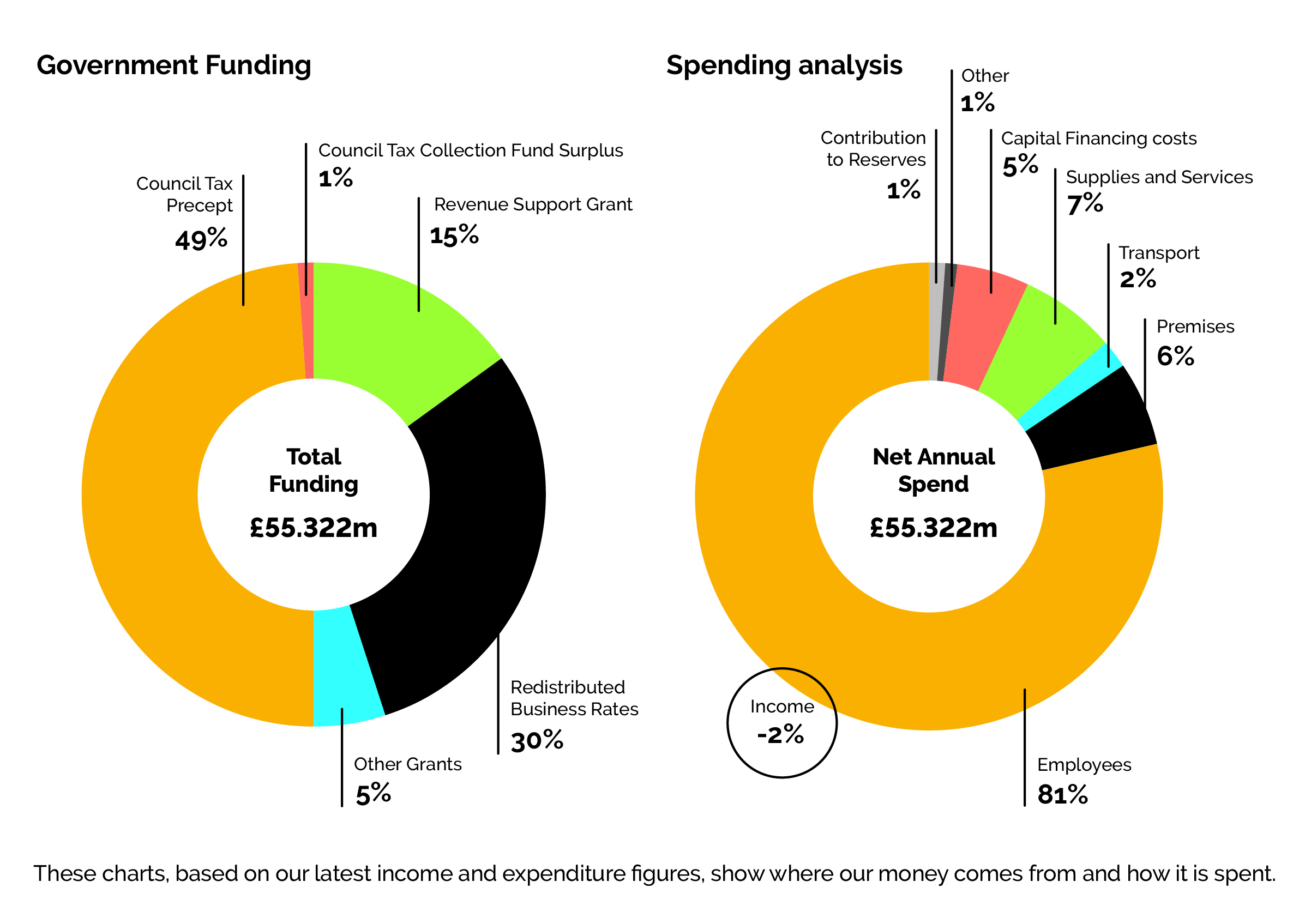
Unlike other public services which are demand led, we need to have enough resources available to provide an emergency response even in times of exceptional demand. This includes the ability to deal with large scale emergencies, a range of smaller incidents that may happen together and/or incidents that are of extended duration. This resilience is vital to ensuring safe systems of work for our people.
Our challenge is to balance our resources against the risks we face. By resources, we mean money and people. By risk, we mean the potential for emergencies to occur that’s everything from fires and road traffic collisions to flooding and even terrorism. Like all public services, we have to work within the budget we’re given. We have adopted a progressive approach to managing our finances making sensible and sustainable efficiencies and savings (about £2m a year from 2020 to 2023) to offset known cost pressures (mostly pay and pensions)- this has enabled us to now be ‘cautiously optimistic’ about our future.
Our financial plan for the next few years clearly shows we have an affordable and sustainable future that will support our plans to:
• Recruit more new firefighters
• Enhance our building safety work to make sure we do enough to ensure premises comply with fire safety regulations
• Invest more in protection activity to ensure we have the capacity and capability for undertaking new duties and responsibilities with regard to high risk, high rise buildings
• Continue to invest in our infrastructure and assets like providing new fire engines, firefighting kit and equipment and on-going technology developments as part of our digital transformation roadmap
This plan assumes government funding levels will at least be maintained and council tax will increase by two percent a year. However, the plan was published shortly before the COVID-19 pandemic. As we pen this document, we still don’t know what the impact of the pandemic will be on the money the government makes available to the fire and rescue sector.
All we do know is that the service has demonstrated its versatility in responding to the crisis, maintaining its ability to respond to emergency and other incidents while simultaneously helping others. To avoid paralysis in decision making we are sticking with our improvement and financial plans until it is clear that we need to change. The government is expected to provide this clarity by the end of 2020, but it may not do so until later in 2021.
Given this financial uncertainty, we have diligently held a higher level of general reserve (£5m) than normal. This is expected to provide a sufficient buffer to work up and enable our Fire Authority members to consider sensible choices to reduce costs, make efficiencies and other savings, should the financial need arise. For every five percent reduction in government grant funding the service would need to save half a million pounds. This equates to the cost of running one wholetime fire station, with one fire engine, for six months.
The remainder of our financial plan considers the sensible use of other reserves that we have available to us. These now stand at £14m and will mostly be used over the next 12 to 24 months to finance the approved investments in new infrastructure. This includes a new Barnsley fire station, the refurbishment of Aston Park, Tankersley and Rivelin fire stations, and other assets, for example a new structural fire kit and rescue jacket. By using reserves to finance these investments we avoid expensive borrowing costs (about £55,000 for every £1m borrowed for the next 25 years) which reduces how much money we have available to spend on people and other day-to-day things.
The service recognises the financial challenges as described in the previous section. To deliver an efficient service, we will continue to consider ways of improving our service whilst operating in a cost effective way. However, if the level of investment in the service drops significantly and we need to make large-scale savings, then we will have to consider a range of options. These will include:
• Matching our response resources to the risks we identify through our risk modelling
• How we crew our fire stations (duty systems)
• When we crew our fire stations (peak period crewing)
• The number of firefighters we crew a fire engine with
• Increased use of ‘on-call firefighters’
• Service support reviews and potential restructures of support functions
• More flexible employment contracts
Efficiencies and investment
We are positive about the future, however uncertain it might be, and this plan does not include any specific proposals to generate efficiency savings. In 2019, the service consulted on proposals to staff fire engines with four firefighters and these were approved by the Fire Authority.
However, we will continue to staff our fire engines with five firefighters wherever possible and consider alternative ways to generate savings if they are required. Our investment plan will also be prepared following a series of internal meetings to determine what our service currently delivers and what demands are being placed on us in the future. The investment plan will also take account of any recommendations given to us through our inspection programme and we have an on-going ‘Service Improvement Plan’ that may require us to invest in some areas of the service.
An example of this is where we will be investing in our fire protection services in response to the Grenfell Tower fire and the increased demands around ensuring commercial buildings are as safe as they can be. We will then hold an annual workforce planning event that will allow managers from all functions within the service to request additional resources, if they feel they are required. Service leaders will then make decisions on the areas that require investment following a gap analysis against what the service needs to deliver to make our communities as safe as they can be.
How we will measure our success
We already publish a set of performance indicators which show how well we are doing at managing risk in our area. These include measures like the number of accidental house fires, injuries and deaths in South Yorkshire, the number of other incidents we attend and statistics relating to our prevention and protection work. We will also now report against the expected response time standards we have set out in this plan. We will internally capture and monitor the benefits of this IRMP, too. All fire and rescue services are regularly inspected by Her Majesty’s Inspectorate of Constabulary and Fire & Rescue Services (HMICFRS), which is another way in which our success at managing local risk can be scrutinised and compared with that of other fire and rescue services.
Consultation on this plan
This is a draft plan. We have made it publicly available on our website so that local people and partner organisations can review it and decide if they agree with our proposals, or not. We’ve already carried out consultation whilst we were developing this plan and have summarised the feedback we received elsewhere in this document. We will consider any further feedback we receive on this plan, before publishing our final Integrated Risk Management Plan in early 2021.

